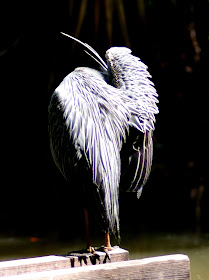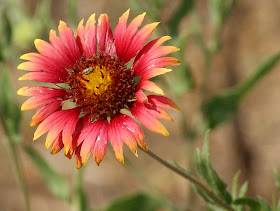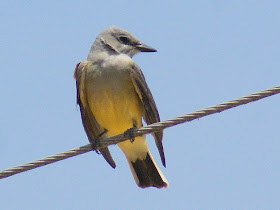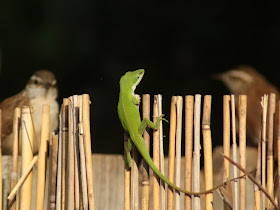.
Earlier this week I popped in to Edith L Moore Nature Center in Houston in the hope of seeing migrating songbirds. The latter were comparatively few and far between but I did manage to see some: Baltimore Oriole, Summer Tanager, Rose-breasted Grosbeak, American Redstart, Great Crested Flycatcher, Yellow-breasted Chat, Common Yellowthroat, Magnolia Warbler, Black-throated Green Warbler, Black-and-white Warbler and Golden-winged Warbler.
Most of the migrants were well out of reach of my lens but a female Rose-breasted Grosbeak flew down to the birdfeeder at the cabin. She looks very different from her beautifully colored partner but that beak is unmistakable.
The most exciting sighting was of an Olive-sided Flycatcher, a life bird for me.
While a group of us watched, the Flycatcher flew up and caught a huge dragonfly.
Then it started to do something very odd. It dropped the dragonfly and then flew down to catch it again as it fell. It went on to do the same thing several times.
Was it just being clumsy? Was the dragonfly a particularly elusive big? Was the bird playing with its prey? Was it practicing its flycatching technique? Who knows! It certainly made for interesting watching, though.
Before I left, I spent some time taking pictures of a family of four Yellow-crowned Night Herons at the pond. The two juveniles were not very active.
One of the adults put on quite a show when it caught and ate a crawdad.
Once it had dealt with the crawdad, the bird decided it was time for preening.
At times the Heron looked more like an abstract sculpture than a bird.
The bird was very tolerant of people and let me get near enough to take head shots from different angles.
.
.
Most of my blog posts are about birds. However, I occasionally like to focus on other aspects of the natural world, particularly when I haven't had much success in finding birds, as was the case on our weekend trip to Bastrop.
On our drive up to the hill country, we saw very few wildflowers by the roadside: It was a little late in the season, plus we have been in a drought for months. So when we came to explore Bastrop and Buescher State Parks and the Lost Pines Nature Trail, I was surprised by the variety of wildflowers that we ran across. Here is a selection.
Given the number of flowers, it wasn't surprising that we also saw quite a few butterflies, including many Pipevine Swallowtails enjoying the yellow prickly pear blossoms.
Not all of the butterflies were busy looking for food. These swallowtails were getting on with the equally important business of mating.
.
.
One of my main reasons for wanting to spend some time in Bastrop was to check out the birds in Bastrop and Buescher State Parks and the surrounding area. However, perhaps because of the very windy conditions, I ended up seeing comparatively few birds - my trip total was only 35 species.
Most of the species I saw were very common ones, such as Carolina Chickadees, Tufted Titmice, (scores of) Northern Cardinals, and Great-tailed Grackles.
Although the area around Alum Creek was very busy with a range of birds, the only migrant that I managed actually to see was a Black-and-White Warbler.
A Wild Turkey by the roadside at Bastrop was a treat but didn't stay for a photo, and a Greater Roadrunner was almost as quick to disappear.
Both state parks had Western Kingbirds ...
... while the Lost Pines Nature Trail along the Colorado River produced a Couch's Kingbird.
The same trail had several Pileated Woodpeckers both times that I walked it.
The trip wasn't a great success as far as birding goes. However, the scenery was wonderful and I enjoyed taking photos of some of the many wildflowers and butterflies. I'll post a selection of these on Thursday.
.
.
As the weather and the scenery at Bastrop were really beautiful that we decided to stay an extra night and so we didn't get home until yesterday. Until I can sort out my photos from the trip, here are some pictures I took of Cliff Swallows building nest under a highway flyover near Bastrop State Park.
If you look carefully at this photo, you can see that the bird's face is partially obscured by its cargo of mud.
In a normal year, the swallows probably don't have to fly far to collect mud. However, given how dry the area is this year, they must be traveling quite some distance to find their next-building material. Since the nests appear to use two different colors of mud, the swallows presumably travel to different sites to collect it.
.
.
Given how windy this week has been, it is not surprising that fewer birds have been visible around the CyFair campus. However, there have been a few new arrivals.
There are now so many Purple Martins that more accommodations are being added to the Martin house.
Colleagues spotted Chuck-wills-widow and Yellow-breasted Chat but I have so far missed both birds. Until yesterday I had also missed the first of our Western Kingbirds to return to the campus. Then yesterday morning I had a brief glimpse of one. It didn't come within camera range but a couple of minutes later I was luckier with a Great Crested Flycatcher.
I also managed to get good views of one of the several pairs of Brown-headed Cowbirds that have been hanging around near the nature trail. As with many species, the male is significantly more colorful than the female.
.
.
Lately my focus has been on spring as the time for hawk, shorebird and songbird migration. However, spring is also the main breeding season for our resident birds. I was reminded of this the other day when a very young juvenile House Finch turned up in our front yard. Constantly cheeping, it hopped around from feeder to feeder but couldn't work out how to use any of them. The poor little thing sounded desperate.
Two juvenile Carolina Wrens have been much luckier. Their parents have been bringing them to our yards and showing them around. Normally each parent keeps a close eye on one juvenile. As you can see from the photos below, the young birds are much less debonair than the adults.
The parents been feeding the juveniles, too. One adult stashed a juvenile safely in the wisteria on our shed and then flew back and forward bringing it grubs and other tasty morsels. This involved some acrobatics.
At one point, the wrens seemed to catch the attention of a Green Anole.
I wondered if the adult wren might decide that anoles are good eating, but the bird totally ignored the reptile.
Away Again
BTW, when you read this, we'll be away in Bastrop, which is between Houston and Austin. We're going there mainly to visit Bastrop and Buescher State Parks. We drive up on Friday morning and return on Saturday afternoon.
.

















































